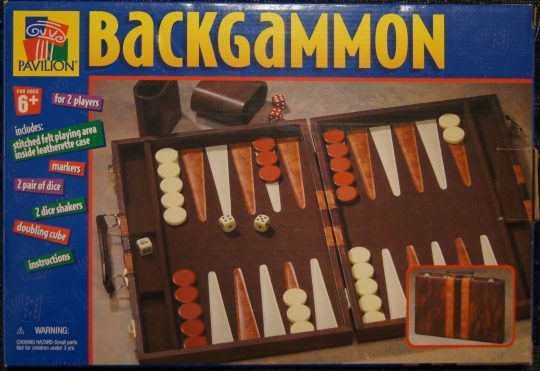
Backgammon
Current Offers for Backgammon
Model Number: 3003868
Note: Ad blockers can interfere with getting the latest price data. Please whitelist boardgamerdeals.com.
-
# Players
2 - 2
-
Playtime
30 Minutes
-
Age
8
-
Year Published
-3000
Game Description
Backgammon is a classic abstract strategy game dating back thousands of years. Each player has a set of 15 "men" that must be moved from their starting positions, around, and then off the board. Dice are thrown each turn, and each player must decide which of his men to move based on the outcome of the roll. Players can capture each other’s men, forcing the captured men to restart their journey around the board. The winner is the first player to get all 15 men off the board. A more recent addition to the game is the "doubling cube", which allows players to up the stakes of the game, as it is often played for money. Although the game relies on dice to determine movement, there is a large degree of strategy in deciding how to make the most effective moves given each dice roll as well as measuring the risk in terms of possible rolls the opponent may get.
Backgammon may be the first game to be mentioned in written history, going back 5,000 years to the Sumerians of ancient Mesopotamia. During the 1920’s, archaeologists unearthed five boards from a cemetery in the ancient town of Ur. At another location, pieces and dice were also found along with the board. Boards from ancient Egypt have also been recovered from the tomb of Tutankhamun, including a mechanical dice box, no doubt intended to stop cheaters.
The names of the game were many. In Persia, Takhteh Nard> which means "Battle on Wood". In Egypt, Tau, which may be the ancestor of Senat. In Rome, Ludus Duodecim Scriptorum ("game of twelve marks"), later, Tabula ("table"), and by the sixth century, Alea ("dice"). In ancient China, T-shu-p-u and later in Japan, Sugoroko. The English name may derive from "Bac gamen" meaning "Back Game", referring to re-entry of taken stones back to the board.
It was often enjoyed by the upper classes and is sometimes called "The Aristocratic Game." The Roman Emperor Claudius was known to be such a fan that he had a set built into his coach so he could play as he traveled (the world’s first travel edition?).
The rules in English were standardized in 1743 by Edmond Hoyle. These remained popular until the American innovations of the 1930’s.
Categories
Groups
Gameplay Mechanics
Publishers
- (Public Domain)
- (Unknown)
- 3M
- Alga
- Ariel Productions Ltd
- Arrow Games Ltd
- ASS Altenburger Spielkarten
- Basic Fun, Inc.
- Bello Games New York, Inc.
- Berliner Spielkarten
- Bisonte
- Blatz
- Bütehorn Spiele
- Cardinal
- Carlit
- Cathay
- Cayro Juegos
- Chad Valley Co Ltd.
- Chadwick Miller Inc.
- Challenge Master Game Co Ltd
- CHH Games
- Classic Toys
- Creative Crafthouse
- Crisloid
- Croner
- Daells Varehus
- Dal Negro
- Deuce
- Dilemma Games
- Dino Toys s. r. o.
- Diset S. A.
- Dos Reis
- Dynamic Games / Dynamic Design Industries
- E.S. Lowe
- Editrice Giochi
- El Greco
- Estrela
- F.X. Schmid
- Fame Products
- Fifth Avenue Crystal Ltd.
- Friendly Games, Inc.
- Fundex
- Galleryplay
- Gammon Games
- Gamut of Games
- Ghisò
- Gibsons
- Gigliodoro
- Glevum Games
- Gold Medal
- Golden
- HABA
- Halsall
- Harlekin
- Hasbro
- Hector Saxe
- HEMA
- Heyne
- House Martin
- House of Marbles
- Inovac Rima SA
- IRWIN Games
- John Jaques of London
- John N. Hansen Co., Inc.
- John Sands Pty Ltd
- Joker
- Juegos Ya S.L.
- Jumbo
- K.E.Leg
- Kingstone International
- Klee
- L. P. Septímio
- Lagoon Games
- Ludens Planet
- LuduScience
- M Petrushkin
- Magnetic Poetry Inc
- Majora
- Marigó
- Marlboro
- Masters Games
- Matsui Gaming Machine
- Maxco
- MB Spellen
- MB Spiele
- Merit
- Milton Bradley
- Mitra
- National Novelty Corp.
- Neroulia
- nestorgames
- Noris Spiele
- Oriental Trading Company
- Origem
- P:OS Handels GmbH
- Palet spil
- Paul Lamond Games Ltd
- Pavilion
- Pelikan
- Peri Spiele
- Philos
- Piatnik
- Pin International
- Pintoy
- play time
- Pleasantime Games
- Poolmaster
- Pressman Toy Corp.
- Przedsiebiorstwo Zagraniczne LABO
- Ramsons
- Ravensburger Spieleverlag GmbH
- Regionalia Verlag GmbH
- Reiss Games
- RoseArt
- S & E
- Saitek
- Schmidt France
- Selchow & Righter
- Silk Cut
- Skor-Mor
- Sladecolour Board Games
- Smethport Specialty Co.
- Søstrene Grene
- Spear's Games
- Square Root Games
- Sterling Games
- Super Accord
- Tactic
- The OP
- Top Mark
- Unicorn Products
- Waddington's Games, Inc.
- Węgiel
- Westside Fun Games
- Whitman
- WHSmith
- Wicked Vision
- Wm F. Drueke & Sons, Inc.
- Wood Expressions
- Zontik Games
